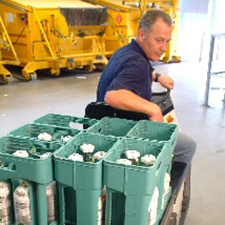Page content
Laws and regulations
Any dangerous substance you purchase must be transported. Rules apply to all types of transport. Ask your OHS advisor for advice. In the Netherlands, the transport of dangerous substances by land is subject to the Carriage of Dangerous Goods Act (abbreviated to WVGS in Dutch), the Carriage of Dangerous Goods Decree (BVGS), the Carriage of Dangerous Substances by Land Regulations (abbreviated to VLG in Dutch) and the European agreement ADR.
The ADR lays down the rules for the transport of dangerous substances on public roads. The rules outlined in the ADR are increasingly being applied to industrial estates and to the internal transport of dangerous substances.
You will be dealing with all these rules if you are going to transport dangerous substances from a central reception point or warehouse to other locations outside the building. You must also comply with ADR(1) when transporting or having a third party transport hazardous waste, including blood and contaminated waste.
(1) Accord Européen relatif au transport international des marchandises Dangereuses par Route (European Agreement concerning the International Carriage of Dangerous Goods by Road)
External transport
External transport of dangerous substances takes place first from the supplier to the UMC and then, if necessary, from one building to another. This requires that you:
- Make clear agreements with the supplier to ensure safe delivery to the right place;
- Draw up separate procedures for supplying or collecting dangerous (waste) materials with a tanker.
Diagnostic samples
Special procedures have been developed for the dispatch of diagnostic samples. Call in a specialist transport company or ask your OHS advisor or the safety advisor for transport of dangerous substances.
Radioactive agents, GMOs, biological agents
Separate transport regulations apply to radioactive substances, genetically modified organisms (GMOs) and biological agents. If you would like to know more about this, please contact your OHS advisor or the appointed expert, such as the radiation expert, the biosafety officer or the safety advisor for the transport of dangerous substances.
Transport by air
Rules for the transport of dangerous substances by air have been laid down by the International Air Transport Association (IATA). For air transport, ask a specialist transport company or the IATA transport mode safety advisor.
Internal transport

Internal transport within buildings usually takes place at locations that are not designed for dangerous substances. The worker in question encounters colleagues, patients and visitors along the way who are now aware that any dangerous substances are being transported. This requires closer attention.
Therefore, give your department's staff the following instructions:
- Preferably do not to plan the route via busy corridors and lifts. Always bear in mind the visiting hours when it comes to transport times;
- If possible, retain the transport packaging (in boxes);
- When unpacking dangerous substances, beware of any breakage or leakage. The hazard statements on the labels of both the transport packaging and the user packaging must be clearly legible to staff;
- Transport loose packaging (bottles, drums and jars) on trolleys. The transport trolleys must be stable and have a closed loading surface with raised edges. Make sure that the packaging cannot fall over;
- Place liquids and highly toxic substances in drip trays. The packaging must be tightly closed;
- Avoid lifting packages heavier than 25 kg;
- Never carry a loose bottle by the cap and for more bottles preferably use a carrycot or a closed bucket;
- Make sure that the outside of bottles, jars and drums is clean;
- Transport of carcinogenic substances (such as cytostatics) in a closed transport container that protects against breakage and leakage and bears the inscription about the contents;
- In principle, dangerous substances should not be transported with the pneumatic tube transport system. If broken, there is always a risk of leakage into the system. For cytostatics, a leak-proof and transparent pneumatic tube capsule must be used;
- Transport gas bottles with special transport trolleys;
- Never leave dangerous substances unattended;
- Use lockable cage or transport trolleys;
- Please read the Cryogenic substances section for specific instructions for this group of dangerous substances;
- Transport rules also apply to the transport of hazardous waste.
The environmental permit may contain additional requirements for the safe transport of dangerous substances within the buildings of a UMC.
